Beware: Boxwood Blight Ahead
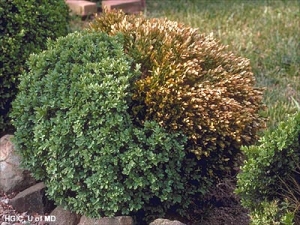
Defoliation and decline characteristic of boxwood blight
A serious fungal disease is threatening boxwoods, one of Fairfax County’s most popular landscape plants. Boxwood blight or box blight, as the disease is known, has been positively diagnosed in random areas of the county, according to Senior Cooperative Extension Agent, Adria Bordas. As a result, all homeowners should assess their boxwoods for any possible signs of the disease, since boxwood blight, once it has taken hold, is very difficult and costly to control with fungicides. If there is a positive diagnosis in your landscape, promptly remove diseased plants and their leaf debris to preserve adjacent healthy boxwoods.
Symptoms of the disease and varying resistance

Brown leaf spots
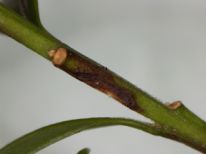
Black streaks on stems
| Susceptibility of 24 commercial boxwood cultivars to boxwood blight | |
| North Carolina State University, 2012 Ornamental Crops Highly susceptible Susceptible |
Moderately susceptible Buxus X ‘Green Mound’ Buxus X ‘Conroe’ (Gordo) B. microphylla ‘Green Pillow’ B. microphylla ‘Grace Hendrick Phillips’ B. microphylla ‘Jim Stauffer’ Buxus X ‘Green Mountain’ Moderately resistant Most resistant (recommended for new plantings) |
Other plant hosts of this disease
Pachysandra terminalis (Japanese spurge), Pachysandra procumbens (Allegheny spurge), and Sarcococca species (sweetbox) which are in the same family (Buxaceae) as boxwood, are also susceptible to boxwood blight. Infected plants of these species can introduce the disease to boxwoods in the landscape. Brown leaf spots on pachysandra have tested positive for the boxwood blight pathogen.
How to avoid introducing boxwood blight
- When purchasing boxwood for your home, ask nursery personnel if their producers participate in the Boxwood Blight Cleanliness Program. In this program, nurseries must follow strict management practices to minimize the spread of the pathogen. The nurseries are also inspected by the Virginia Department of Agriculture and Consumer Services.
- Before planting, carefully inspect plants for symptoms: leaf spots and black streaks on stems.
- Continue to monitor all boxwood, established and new, for any symptoms.
- Be aware: Boxwood greenery used for holiday decorations could harbor the boxwood blight pathogen. Do not use boxwood greenery near landscape boxwood. When taking down holiday decorations, double-bag boxwood greenery and dispose of it in a landfill. Do not add it to your compost.
If you suspect boxwood blight in your landscape
Take cuttings of symptomatic boxwood, double-bag them in plastic bags and take them to the county Virginia Cooperative Extension office, 12011 Government Center Pkwy, 10th fl., Fairfax. It is important to seek a confirmatory diagnosis because the symptoms could be mistaken for other less serious problems such as winter burn or volutella leaf blight. The Virginia Cooperative Extension keeps track of where outbreaks occur and the source of the diseased plant material.
If the diagnosis is positive
- Remove promptly any diseased plant, along with its leaf debris. However, this will not eliminate the pathogen from the area, since it can persist in the soil for five or six years. Do not plant susceptible boxwood varieties where the diseased boxwood was removed. (See chart for boxwood levels of susceptibility.)
- If leaf debris has been worked into the soil, remove 8 to 12 inches to help eliminate the pathogen.
- Bag diseased boxwood, leaf debris and soil, and take to a landfill. Do not compost this material.
- Sanitize all tools, equipment, tarps, shoes, gloves, spray hoses and exposed areas of vehicles with either Lysol Concentrate Disinfectant (1.25 oz./gal.) or household bleach (1 part bleach/9 parts water).
- Begin preventative fungicide spray program on any susceptible boxwood. Fungicides with chlorothalonil are recommended for the home gardener. Continue preventative applications throughout the growing season every one to two weeks per label instructions. If temperatures are over 60 degrees post-season and rain is expected, continue the fungicide treatments.
Best practices with boxwood plantings
- Choose cultivars with an open-growth habit for better air circulation. Allow adequate spacing between plants.
- Avoid overhead irrigation. Direct watering toward the root area. Mulch boxwoods to reduce the spread of disease to foliage from splashing water. Do not work in area if boxwoods are wet to prevent the spread of fungus.
- Discuss your concerns about boxwood blight with your landscaping professionals. Keep records of any diseased plants, names and planting dates of new boxwoods, and fungicide applications.
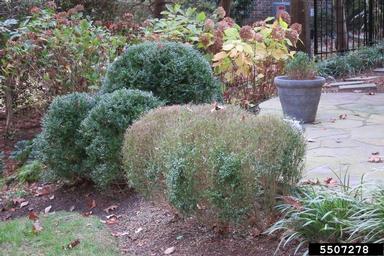
Boxwood blight
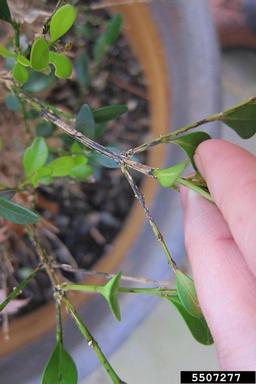 Black stems |
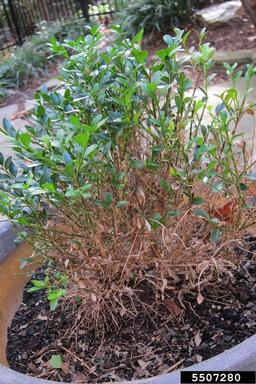 Boxwood blight |
Also see the Bulletin on Boxwood Blight from Virginia Cooperative Extension.
References
Boxwood Blight Task Force, Virginia Cooperative Extension
Best Management Practices for Boxwood Blight, Virginia Cooperative Extension